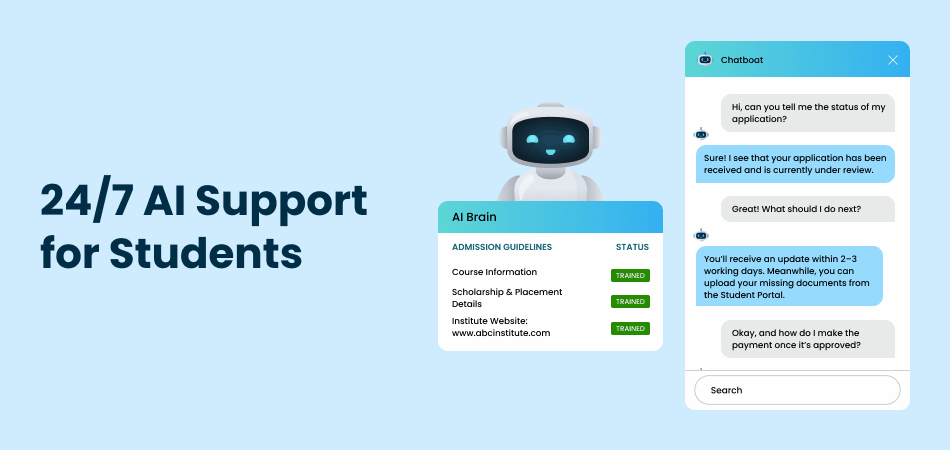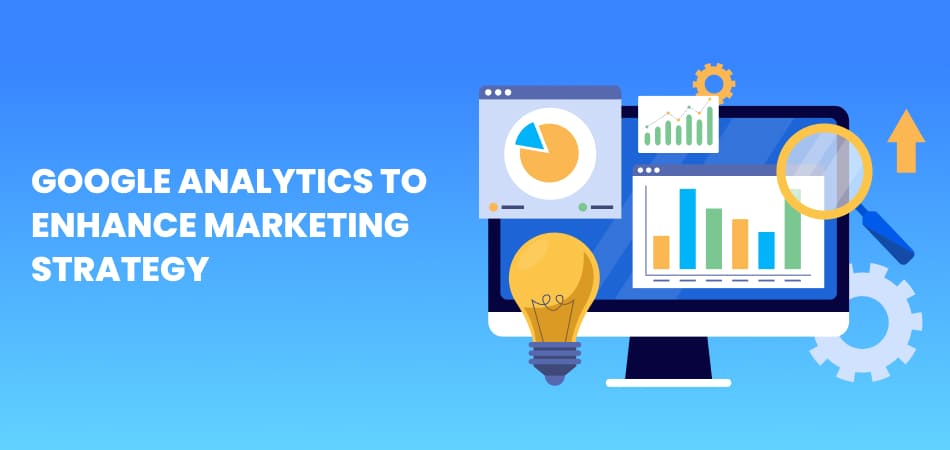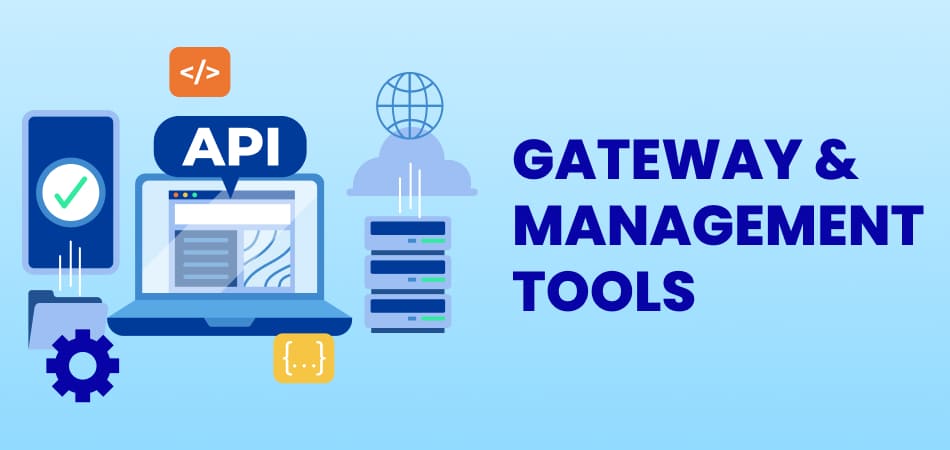Introduction: The New Era of Student Support Virtual Assistants
In today’s fast-paced digital world, prospective and current students expect instant access to information. An unanswered query, particularly during the high-stress period of enrollment, can mean the difference between an applicant choosing your institution or a competitor. The clock doesn’t stop, but human staff do. This critical gap is exactly where AI Chatbots for Institutes have emerged as the game-changing solution.
These aren’t the clunky, rule-based “bots” of a decade ago. Modern educational chatbots, powered by advanced Natural Language Processing (NLP) and Generative AI, are sophisticated, contextual, and capable of holding human-like conversations. They serve as a 24/7 support virtual assistant, fundamentally transforming how colleges, universities, and schools manage everything from initial inquiry to final enrollment.
This comprehensive guide explores how integrating AI into your student services can not only streamline your admissions workflow but also drastically improve the overall student experience, ensuring your institute remains competitive in the evolving landscape of higher education.
The Essential Role of AI Chatbots in Modern Admissions
The admissions cycle is characterized by seasonal peaks. Enrollment windows, financial aid deadlines, and the crucial “summer melt” period—when admitted students drop off before starting classes—create an overwhelming volume of repetitive inquiries. Without scalable support, staff burn out, response times balloon, and student satisfaction plummets.
AI chatbots solve this by acting as a powerful front line of support, automating the most common queries and enabling staff to focus on high-value interactions.
24/7 Availability: Never Miss a Prospect
The primary and most compelling benefit of an AI chatbot for student admissions is its round-the-clock availability. Prospective students often research and apply outside of typical business hours, whether they are international applicants in different time zones or domestic applicants balancing work and study.
- Global Reach: Instantly engage international students researching your programs at 3:00 AM their local time.
- Instant Gratification: Provide immediate answers to questions like “What is the application deadline for the Fall semester?” or “What GPA is required for the Engineering program?”
- Lead Capture: Engage visitors immediately and capture critical contact information, turning casual website browsing into qualified leads even when your admissions office is closed.
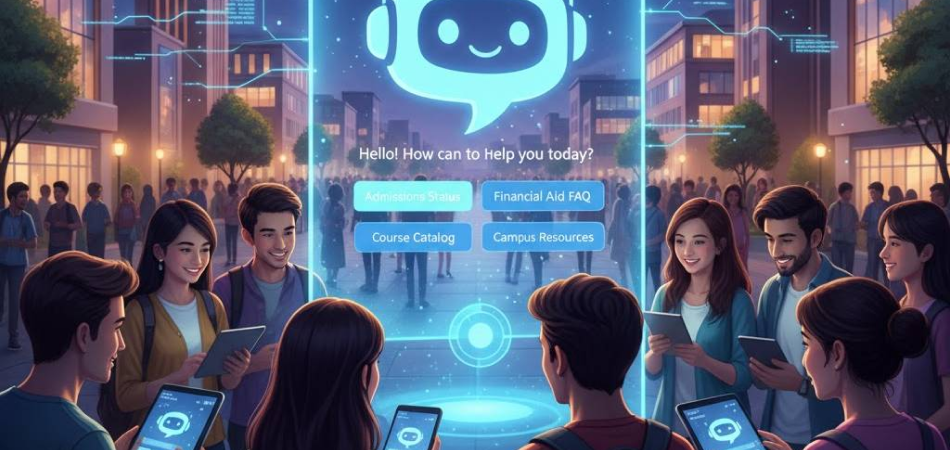
Admissions Automation: Streamlining the Enrollment Funnel
An admissions automation virtual assistant does far more than answer general FAQs. It can be integrated directly into your Student Information Systems (SIS) and Customer Relationship Management (CRM) tools to provide personalized and actionable guidance throughout the entire applicant journey.
| Stage of Admission | Chatbot Functionality |
| Inquiry/Lead | Answer general course questions, collect contact details, qualify lead status. |
| Application | Guide applicants through complex form sections, provide document checklists, and send deadline reminders to reduce ‘summer melt’ (an issue Georgia State University famously tackled with their ‘Pounce’ chatbot). |
| Decision/Financial Aid | Provide real-time status updates on applications (“Has my transcript been received?”), answer FAQs about scholarship eligibility, and guide students through FAFSA forms. |
| Onboarding | Help accepted students with mandatory orientation registration, housing applications, and first-semester course enrollment. |
By automating these steps, your admissions team is freed up to engage in personalized outreach to high-priority candidates and handle complex, nuanced cases that require human empathy and decision-making.
Key Benefits of AI Chatbots for Higher Education
The impact of AI chatbots for higher education extends beyond the admissions office, creating a ripple effect of efficiency and improved service across the entire institution.
1. Reduced Workload and Cost Efficiency
Institutes constantly struggle with budget and staffing constraints, particularly in front-line services.
- Filtering Repetitive Queries: Studies show that a high percentage of student and faculty inquiries are highly repetitive. AI can handle 70-80% of these common questions, freeing up human staff.
- Lower Operational Costs: Providing 24/7 live human support is prohibitively expensive. A single educational chatbot can handle thousands of simultaneous conversations without overtime or burnout.
- Staff Focus on Complex Issues: Staff are re-tasked from answering “Where is the library?” to complex advising, emotional support, or handling high-level administrative tasks.
2. Enhanced Student Experience and Retention
Student satisfaction is directly linked to retention. A student who feels supported and can easily access resources is more likely to succeed.
- Instant, Personalized Answers: Modern student support virtual assistants use student data (like their program, year, or financial aid status) to deliver highly personalized responses, making the interaction feel tailored and less generic.
- Accessibility: Chatbots offer a non-judgmental space for students to ask “silly” or basic questions they might feel embarrassed to ask a staff member. This is crucial for first-generation and international students navigating new systems.
- Academic Support Integration: Beyond administration, chatbots can integrate with Learning Management Systems (LMS) to answer course-specific questions, provide instant tutoring help, or guide students to relevant study resources.
3. Actionable Data Insights
Every conversation the AI chatbot for institutes has is a data point. This rich, real-time data is invaluable for institutional improvement.
- Identifying Pain Points: Chatbot analytics immediately highlight the most frequently asked questions and the queries the bot struggles to answer. This reveals common administrative bottlenecks or gaps in published information (e.g., if “How do I print on campus?” is a top query, the institute knows to update the knowledge base).
- Forecasting Demand: Data allows the administration to forecast peak inquiry periods and strategically allocate human resources where they are most needed.
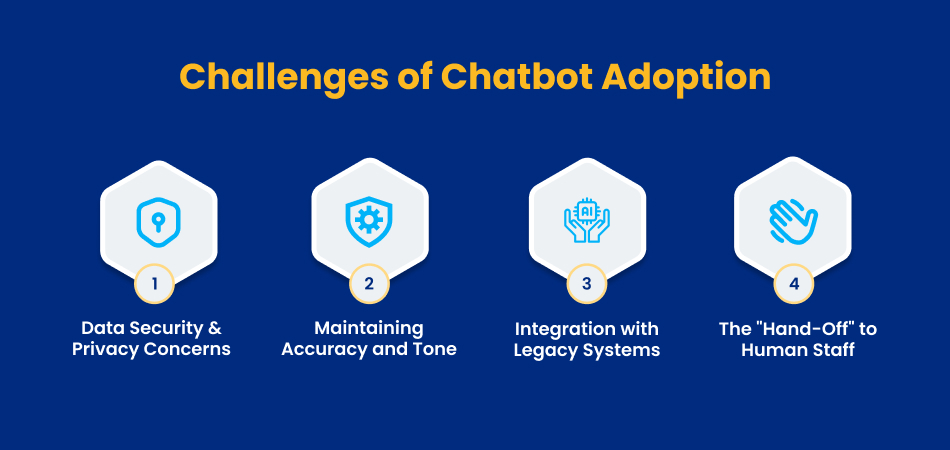
Challenges and Solutions for AI Chatbot Implementation
While the benefits are clear, successfully implementing an AI chatbot requires strategic planning to overcome common challenges.
Challenges of Chatbot Adoption
- Data Security and Privacy Concerns: Handling sensitive student data (academic records, financial aid status, PII) requires strict compliance with regulations like GDPR and FERPA.
- Maintaining Accuracy and Tone: A poorly trained bot can provide inaccurate information or use an inappropriate, robotic tone, leading to student frustration and distrust.
- Integration with Legacy Systems: Many older Student Information Systems (SIS) and Enterprise Resource Planning (ERP) tools may not easily interface with modern AI platforms.
- The “Hand-Off” to Human Staff: Students get frustrated when a bot cannot resolve their issue and the escalation process to a human is slow or confusing.
Practical Implementation Solutions
| Challenge Area | Recommended Solution |
| Security & Data | Prioritize Compliance: Select a vendor that explicitly guarantees compliance (e.g., FERPA-compliant encryption). Implement a clear, transparent AI usage policy for students and staff. |
| Accuracy & Training | Invest in Knowledge Base (KB): The bot is only as good as its training data. Consolidate and curate high-quality, up-to-date FAQs, policies, and process guides to feed the AI. Use human feedback loops for continuous improvement. |
| System Integration | API-First Approach: Choose a platform that offers robust, open Application Programming Interfaces (APIs) for seamless integration with existing campus software. Start small (e.g., admissions only) before expanding. |
| Human Handoff | Clear Escalation Paths: Design the chatbot workflow to clearly indicate when an issue is too complex. Implement instant-routing to the correct human staff member (e.g., “Transfer to Financial Aid Advisor”) with the full chat transcript attached. |
FAQs on Educational Chatbots
Q1: Will an AI Chatbot replace human admissions or support staff?
A: No. AI chatbots for institutes are designed to complement, not replace, human staff. They handle the volume of routine and repetitive queries, which frees up admissions counselors, academic advisors, and support staff to concentrate on complex, high-touch interactions such as personalized advising, recruitment strategy, mental health support, and complex enrollment issues. They serve as a force-multiplier for your existing teams.
Q2: How is a modern AI chatbot different from the old ‘click-bot’?
A: Old click-bots were rule-based; they only responded to specific keywords or menu choices. Modern AI Chatbots use advanced Natural Language Processing (NLP) and Generative AI (like large language models) to understand the intent and context of a student’s question, even if the phrasing is complex, slang, or contains errors. They can maintain a conversational thread, remember past interactions, and provide detailed, synthesized answers rather than just linking to a document.
Q3: What is “Summer Melt” and how does a chatbot prevent it?
A: Summer melt is a phenomenon where admitted students, especially those from low-income or first-generation backgrounds, fail to matriculate (enroll) between the time they accept admission and the first day of class. This is often due to administrative confusion regarding forms, financial aid, or enrollment logistics. Chatbots reduce melt by providing 24/7, personalized reminders and clarification on these administrative hurdles, ensuring students have the confidence and information needed to show up on day one.
Q4: Can AI chatbots support multiple languages?
A: Yes. Modern platforms leverage robust translation and multilingual NLP models, allowing them to support multiple languages instantly. This is an enormous benefit for international recruitment and supporting a diverse student body, ensuring equitable access to information regardless of a student’s native language.
Conclusion: Securing Your Institute’s Future with 24/7 Support
The implementation of AI Chatbots for Institutes is no longer an optional digital upgrade; it is a necessity for maintaining a competitive edge and meeting the service expectations of the modern student. From providing personalized, instant responses during the critical admissions phase to offering seamless, 24/7 support for student queries throughout the academic year, these student support virtual assistants are empowering institutions to be more efficient, responsive, and student-centric.
By automating the mundane, you allow your talented human staff to focus on the meaningful. The result is a streamlined admissions funnel, a significant reduction in operational costs, and, most importantly, a marked improvement in student satisfaction and retention.
Call to Action (CTA)
Is your institution ready to stop losing high-potential applicants to unanswered queries?
Contact our team today for a free consultation and personalized demo to discover how our custom-built AI Chatbots can start driving admissions automation and 24/7 support for your students tomorrow!
